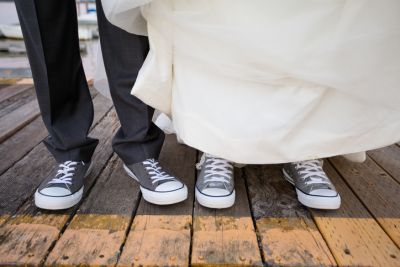 By now, you’ve probably heard tons of fashion “rules” when it comes to selecting attire for your nuptials. While some of these guidelines are meant to guarantee a great look, you’ve got some creative latitude when it comes to others. Your venue and formality level will dictate how far off the beaten path you go. Here are a few pieces of conventional wedding apparel wisdom that you can safely modify or even ignore.
By now, you’ve probably heard tons of fashion “rules” when it comes to selecting attire for your nuptials. While some of these guidelines are meant to guarantee a great look, you’ve got some creative latitude when it comes to others. Your venue and formality level will dictate how far off the beaten path you go. Here are a few pieces of conventional wedding apparel wisdom that you can safely modify or even ignore.
To Veil or Not to Veil?
In Western weddings, veils have been a ubiquitous staple in traditional bridalwear. While this style of headgear has carried with it connotations of purity and virginity, brides donned it as far back as ancient Rome to ward off evil spirits. Nevertheless, this is one custom that might be worth abandoning if you plan to wear a wedding dress. The Knot offers several alternative recommendations besides the traditional piece of tulle, including floral wreaths, jeweled headpieces or even a simple short veil attached to an easily removable headband.
Liven Up a Plain Suit
Weddings are normally seen as serious occasions, and the customary formal dress codes reflect this mindset. Evening ceremonies usually call for tuxedos or dark suits with coordinating dark-colored footwear and an appropriately styled tie, but a less formal affair may give some you leeway in your apparel choices. The Independent published an article in July 2017 that encouraged some artful rule-breaking, focusing on seven “tried and true” aphorisms that can be forgotten under the right circumstances. One example is the “matching socks and trousers” rule, a holdover from more sartorially conservative eras. Jennie Ma’s guide to grooms’ fashion in The Knot encourages unique accessorizing to create a unified look and to set you apart from your attendants. Funky socks and fun cufflinks are certainly not off the table, as long as you give some thought to your selections and take your theme and color palette into account.
Give Your Feet a Break
High-heeled shoes have been part of standard bridal attire for many generations. Even so, their added height and elegant looks also come with a painful price. Between the ceremony and the reception, you could easily be standing, walking or dancing for eight hours or more. Considering that you’re shifting much of your body’s mass onto your toes and the balls of your feet, it’s no wonder why a long day in heels has them begging for mercy. If you’d rather skip the agony, try cute wedding shoes in lower heel heights or even a gorgeous pair of flats.
The Right Time for a Tuxedo
One common practice that’s perceived to be a “rule” is the practice of wearing tuxedos at weddings. Business Insider contributor Dennis Green speculates that the formalwear industry may be partially to blame, but also revealed that tuxes are not the standard for events before sundown. Typically associated with “formal” or “black tie” evening celebrations, they slowly became the look du jour once traditional daytime formalwear fell out of fashion in the United States. Ironically, you’ll follow older customs and stand out from the pack if you choose morning dress for your formal daytime affair. That means a coat with long tails, a waistcoat, grey striped trousers and an ascot. Alternatively, a smartly tailored suit is always appropriate for either day or evening nuptials.
Your Wedding, Your Rules
While planning your wedding, it’s a good idea to take nothing for granted. To craft your own unique celebration, you and your sweetie may want to take a good hard look at typical wedding traditions and decide what to keep and what to toss. Rather than just assume what each of you will wear, take your event’s formality level, its theme and your distinct personalities into account. You may be surprised at just how creative you can become.
Add Your Comment